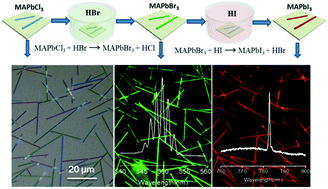当前位置:
X-MOL 学术
›
J. Mater. Chem. C
›
论文详情
Our official English website, www.x-mol.net, welcomes your
feedback! (Note: you will need to create a separate account there.)
Multi-color perovskite nanowire lasers through kinetically controlled solution growth followed by gas-phase halide exchange
Journal of Materials Chemistry C ( IF 5.7 ) Pub Date : 2017-11-02 00:00:00 , DOI: 10.1039/c7tc03939e Xianxiong He 1, 2, 3, 4 , Peng Liu 4, 5, 6, 7 , Suning Wu 1, 2, 3, 4 , Qing Liao 1, 2, 3, 4 , Jiannian Yao 1, 2, 3, 4, 5 , Hongbing Fu 1, 2, 3, 4, 5
Journal of Materials Chemistry C ( IF 5.7 ) Pub Date : 2017-11-02 00:00:00 , DOI: 10.1039/c7tc03939e Xianxiong He 1, 2, 3, 4 , Peng Liu 4, 5, 6, 7 , Suning Wu 1, 2, 3, 4 , Qing Liao 1, 2, 3, 4 , Jiannian Yao 1, 2, 3, 4, 5 , Hongbing Fu 1, 2, 3, 4, 5
Affiliation

|
Integration of multi-color semiconductor nanowire lasers (NWLs) on a silicon substrate is a very challenging task, owing to both the material lattice mismatch and the incompatible growth temperature. Recently, organic–inorganic perovskite (CH3NH3PbX3; X = Cl, Br, I) NWLs have been developed using a surface-initiated solution-growth method, which, however, requires post-synthesis transfer of nanowires from a growth substrate to a silicon wafer for device fabrication. Herein, we report multi-color perovskite nanowire lasers on arbitrary substrates (silicon or quartz substrates) through kinetically controlled growth followed by gas-phase halide exchange. First, we developed an antisolvent–vapor-diffusion induced crystallization method to kinetically direct the growth of CH3NH3PbCl3 towards single-crystal nanowires rather than the crystal habit of plate-like morphology. The ratio of nanowires to square microplates was adjusted to be as high as 97% : 3%. Then we introduced a gas-phase halide-anion-exchange reaction to convert chloride nanowires into bromide and iodide ones upon exposure to the vapor of HX (X = Br, I), while preserving both the high crystallinity and the nanowire morphology. Upon optical excitation, Fabry–Perot lasing around 550 and 785 nm occurs from CH3NH3PbBr3 and CH3NH3PbI3 nanowires with an onset of 9.8 and 9.2 μJ cm−2, respectively, with a maximum quality factor of 1260.
中文翻译:

动力学控制溶液生长,然后进行气相卤化物交换的多色钙钛矿纳米线激光器
由于材料晶格失配和生长温度不兼容,在硅基板上集成多色半导体纳米线激光器(NWL)是一项非常具有挑战性的任务。最近,有机-无机钙钛矿(CH 3 NH 3 PbX 3; X = Cl,Br,I)NWL是使用表面引发的溶液生长方法开发的,然而,这需要将纳米线从合成衬底的合成后转移到器件制造的硅晶片上。在本文中,我们报告了通过动力学控制的生长,然后进行气相卤化物交换,在任意衬底(硅或石英衬底)上的多色钙钛矿纳米线激光器。首先,我们开发了一种由反溶剂-蒸汽扩散诱导的结晶方法,以动力学方式指导CH 3 NH 3 PbCl 3的生长。倾向于单晶纳米线,而不是板状形态的晶体习惯。纳米线与方形微板的比例被调整为高达97%:3%。然后,我们引入了气相卤化物-阴离子交换反应,将氯化物纳米线在暴露于HX(X = Br,I)的蒸汽中时转化为溴化物和碘化物,同时保留了高结晶度和纳米线形态。在光激发时,CH 3 NH 3 PbBr 3和CH 3 NH 3 PbI 3纳米线的Fabry-Perot激射发生在550和785 nm附近,起始时间分别为9.8和9.2μJcm -2,最大质量因数为1260 。
更新日期:2017-11-15
中文翻译:

动力学控制溶液生长,然后进行气相卤化物交换的多色钙钛矿纳米线激光器
由于材料晶格失配和生长温度不兼容,在硅基板上集成多色半导体纳米线激光器(NWL)是一项非常具有挑战性的任务。最近,有机-无机钙钛矿(CH 3 NH 3 PbX 3; X = Cl,Br,I)NWL是使用表面引发的溶液生长方法开发的,然而,这需要将纳米线从合成衬底的合成后转移到器件制造的硅晶片上。在本文中,我们报告了通过动力学控制的生长,然后进行气相卤化物交换,在任意衬底(硅或石英衬底)上的多色钙钛矿纳米线激光器。首先,我们开发了一种由反溶剂-蒸汽扩散诱导的结晶方法,以动力学方式指导CH 3 NH 3 PbCl 3的生长。倾向于单晶纳米线,而不是板状形态的晶体习惯。纳米线与方形微板的比例被调整为高达97%:3%。然后,我们引入了气相卤化物-阴离子交换反应,将氯化物纳米线在暴露于HX(X = Br,I)的蒸汽中时转化为溴化物和碘化物,同时保留了高结晶度和纳米线形态。在光激发时,CH 3 NH 3 PbBr 3和CH 3 NH 3 PbI 3纳米线的Fabry-Perot激射发生在550和785 nm附近,起始时间分别为9.8和9.2μJcm -2,最大质量因数为1260 。











































 京公网安备 11010802027423号
京公网安备 11010802027423号